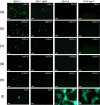The role of glycoprotein H of equine herpesviruses 1 and 4 (EHV-1 and EHV-4) in cellular host range and integrin binding
- PMID: 22909178
- PMCID: PMC3522555
- DOI: 10.1186/1297-9716-43-61
The role of glycoprotein H of equine herpesviruses 1 and 4 (EHV-1 and EHV-4) in cellular host range and integrin binding
Abstract
Equine herpesvirus type 1 and 4 (EHV-1 and EHV-4) glycoprotein H (gH) has been hypothesized to play a role in direct fusion of the virus envelope with cellular membranes. To investigate gH's role in infection, an EHV-1 mutant lacking gH was created and the gH genes were exchanged between EHV-1 and EHV-4 to determine if gH affects cellular entry and/or host range. In addition, a serine-aspartic acid-isoleucine (SDI) integrin-binding motif present in EHV-1 gH was mutated as it was presumed important in cell entry mediated by binding to α4β1 or α4β7 integrins. We here document that gH is essential for EHV-1 replication, plays a role in cell-to-cell spread and significantly affects plaque size and growth kinetics. Moreover, we could show that α4β1 and α4β7 integrins are not essential for viral entry of EHV-1 and EHV-4, and that viral entry is not affected in equine cells when the integrins are inaccessible.
Figures






Similar articles
-
Comparative analysis of glycoprotein B (gB) of equine herpesvirus type 1 and type 4 (EHV-1 and EHV-4) in cellular tropism and cell-to-cell transmission.Viruses. 2015 Feb 3;7(2):522-42. doi: 10.3390/v7020522. Viruses. 2015. PMID: 25654240 Free PMC article.
-
Glycoproteins D of equine herpesvirus type 1 (EHV-1) and EHV-4 determine cellular tropism independently of integrins.J Virol. 2012 Feb;86(4):2031-44. doi: 10.1128/JVI.06555-11. Epub 2011 Dec 14. J Virol. 2012. PMID: 22171258 Free PMC article.
-
Glycoprotein H and α4β1 integrins determine the entry pathway of alphaherpesviruses.J Virol. 2013 May;87(10):5937-48. doi: 10.1128/JVI.03522-12. Epub 2013 Mar 20. J Virol. 2013. PMID: 23514881 Free PMC article.
-
Equine herpesviruses type 1 (EHV-1) and 4 (EHV-4)--masters of co-evolution and a constant threat to equids and beyond.Vet Microbiol. 2013 Nov 29;167(1-2):123-34. doi: 10.1016/j.vetmic.2013.06.018. Epub 2013 Jul 6. Vet Microbiol. 2013. PMID: 23890672 Review.
-
A review of equid herpesvirus 1 for the veterinary practitioner. Part A: clinical presentation, diagnosis and treatment.N Z Vet J. 2014 Jul;62(4):171-8. doi: 10.1080/00480169.2014.899945. N Z Vet J. 2014. PMID: 24597778 Review.
Cited by
-
Crystal structures of glycoprotein D of equine alphaherpesviruses reveal potential binding sites to the entry receptor MHC-I.Front Microbiol. 2023 May 11;14:1197120. doi: 10.3389/fmicb.2023.1197120. eCollection 2023. Front Microbiol. 2023. PMID: 37250020 Free PMC article.
-
Equine Alphaherpesviruses Require Activation of the Small GTPases Rac1 and Cdc42 for Intracellular Transport.Microorganisms. 2020 Jul 7;8(7):1013. doi: 10.3390/microorganisms8071013. Microorganisms. 2020. PMID: 32645930 Free PMC article.
-
Comparative analysis of glycoprotein B (gB) of equine herpesvirus type 1 and type 4 (EHV-1 and EHV-4) in cellular tropism and cell-to-cell transmission.Viruses. 2015 Feb 3;7(2):522-42. doi: 10.3390/v7020522. Viruses. 2015. PMID: 25654240 Free PMC article.
-
Development of a live attenuated vaccine candidate for equid alphaherpesvirus 1 control: a step towards efficient protection.Front Immunol. 2024 Jul 3;15:1408510. doi: 10.3389/fimmu.2024.1408510. eCollection 2024. Front Immunol. 2024. PMID: 39021566 Free PMC article.
-
Binding of alphaherpesvirus glycoprotein H to surface α4β1-integrins activates calcium-signaling pathways and induces phosphatidylserine exposure on the plasma membrane.mBio. 2015 Oct 20;6(5):e01552-15. doi: 10.1128/mBio.01552-15. mBio. 2015. PMID: 26489864 Free PMC article.
References
-
- King AMQ, Adams MJ, Carstens EB, Lefkowitz EJ. Virus Taxonomy: Ninth Report of the International Committee on Taxonomy of Viruses. UK: Academic Press, Elsevier; 2012. pp. 114–115.
-
- Telford EA, Watson MS, Perry J, Cullinane AA, Davison AJ. The DNA sequence of equine herpesvirus-4. J Gen Virol. 1998;79:1197–1203. - PubMed
-
- Gryspeerdt AC, Vandekerckhove AP, Garre B, Barbe F, Van de Walle GR, Nauwynck HJ. Differences in replication kinetics and cell tropism between neurovirulent and non-neurovirulent EHV1 strains during the acute phase of infection in horses. Vet Microbiol. 2009;142:242–253. - PubMed
Publication types
MeSH terms
Substances
LinkOut - more resources
Full Text Sources

